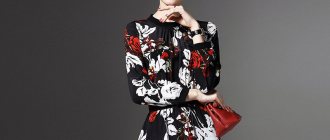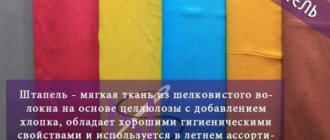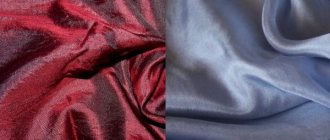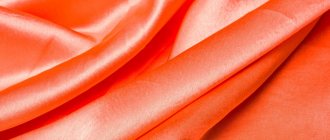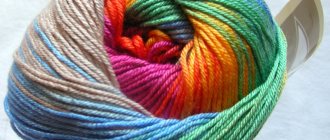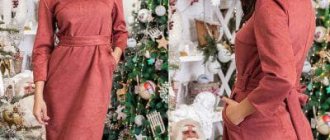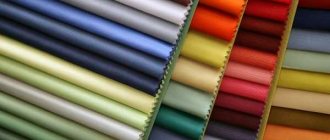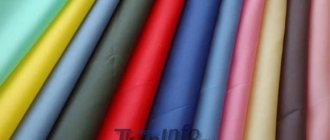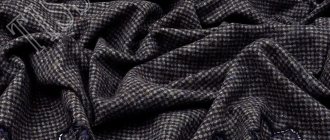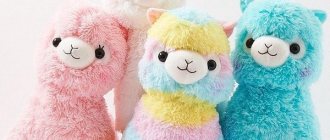As soon as spring comes, beautiful owners of airy, flying outfits appear on the streets of our cities: here are dresses of various colors, flared skirts, and translucent blouses of bright colors. Dresses with a flying silhouette are very popular in the warm season.
The modern choice of fabrics is huge, but chiffon-crepe is especially popular: a symbol of comfort for the consumer with high quality material. Let's look at the description of the fabric to understand why this material is so in demand.
Description
Crepe chiffon fabric - what is it? Unlike chiffon, the material is almost opaque (does not show through), and it differs from crepe in its thinness and lightness. The description of crepe chiffon fabric can be given as follows - an opaque, lightweight double-sided fabric with a grainy structure, slightly rough to the touch.
The canvas is created as follows:
- The warp and weft threads are twisted in opposite directions (right and left). The twist is quite dense, sometimes up to 3000 revolutions per 1 square meter of fabric
- After twisting, plain weave is used
- Next, the material is exposed to high temperatures, which provides a special, “grainy” structure of this fabric
You can see what crepe chiffon fabric looks like in the photo:
Does this matter stretch or not? Due to the nature of the crepe weave, the material is not at all elastic. Price per meter – from 150 rubles (synthetic fiber), from 1500 rubles (natural raw materials).
Crepe Chiffon fabric: description and characteristics
Most often, crepe chiffon is presented in the form of a plain material with bright or any other color. To give the fabric a more elegant look, a pattern can be printed on its surface. The manufacturing process involves the use of natural silk threads, and the weave is linen. Thanks to the drapery, the wave of folds makes it possible to bring the most daring styles into reality.
Crepe chiffon is a delicate material, so you should be very careful when wearing a finished product based on it. You can combine transparent fabric with knitwear. An excellent effect is achieved when combined with satin. Fashionistas can wear this outfit when going to a special event. Jabots, cuffs and collars made from chiffon crepe fabric will be a wonderful decoration and can compete with any other accessories.
Since crepe chiffon is a delicate, light fabric, products made from it are frivolous and romantic.
This material makes excellent skirts and blouses. The most important thing in this matter is not to overdo it with transparency. Sewn items made from chiffon should emphasize femininity and figure.
Decorative pillows in Provence style can become a real decoration for your living room.
What size of a one-and-a-half blanket is considered standard?
Photo of cassette roller blinds for plastic windows: .
The material is woven using the crepe method, which is how it got its name. All one m2 of this fabric is 35 g. Crepe chiffon is rarely found bleached; as a rule, it is sold dyed one color or with a printed pattern. The surface of the material is matte, but the strong, coated chiffon has a characteristic shine. The fabric has no front and back sides. It feels very pleasant to the touch: thin, light and glides between your fingers.
The presented material is not without its shortcomings:
- difficult to process;
- disobedient when cutting and sewing;
- For sewing products it is necessary to use thin threads and needles.
Compound
The composition of the material includes silk fiber - in different quantities, which determines the cost of an item made from this material. Sometimes silk threads are completely replaced with synthetic ones, and the material loses significantly in price. For the production of crepe chiffon they use:
- Silk
- Cotton
- Viscose
- Polyester
- Polyamide
We recommend that you read:
- What is crepe-satin fabric (there is a photo in the article);
- Georgette fastening material and its properties;
- Description and definition of the group of crepe materials;
Where is it used?
Crepe chiffon is used in the vast majority of cases for tailoring, due to its properties and composition.
Application area:
- For sewing airy, light things - blouses, dresses, sundresses, skirts.
- As a finishing material for various products.
- Jabots, brooches, bows, flounces, and decorative cuffs are made.
- Concert costumes are made.
Cutting from crepe chiffon is inconvenient, the fabric spreads and diverges, but the results, as a rule, exceed expectations. The fabric drapes easily, but does not weigh down the image or the product itself. Ideal for creating romantic images.
Advice! For summer, choose items made from crepe chiffon, which contains natural silk rather than synthetic fibers. Such material requires delicate, careful care and is more expensive, but it will be incredibly pleasant to the body and will give coolness on hot summer days.
Due to the fact that crepe chiffon perfectly retains moisture and is not subject to deformation, it is used in the cosmetics industry, shipbuilding and some other industries.
Advantages and disadvantages
To get an idea of matter, it is worth focusing on its characteristics, positive and negative properties.
Advantages
- The matter, although dense and opaque, is surprisingly airy
- The fabric is double-sided - the front side cannot be distinguished from the back side
- Spectacular grainy texture
- Crepe chiffon is resistant to mechanical damage and tearing
- You can use it to create beautiful draperies
- Things don't fade when washed
- Colors well, a huge palette of colors and interesting prints
- Does not cause skin irritation
Flaws
- Not very convenient to process; difficulties may arise when cutting and sewing
- May shrink when washed
- If it contains silk fibers, the material is high maintenance
Sewing Tips
It is better to cut it tightly with a disc knife on a special lining. If you don’t have a knife, you can use regular scissors, but be very careful. The product should be pinned with thin, sharp pins; any unevenness on it can damage the fabric.
Material cutting
Note! You need to sew only with the thinnest silk needles.
It is best to make markings with soap; this cannot be done using a toothed wheel, as marks will remain on the outside.
Interesting color
Application
It is used to create light and airy dresses, sundresses, suits, skirts and other items of women's wardrobe, as well as for decorative finishing of “every day” items. Owners of curvaceous figures leave excellent reviews about the crepe chiffon material - outfits made from this fabric perfectly hide figure imperfections and make the image light and airy.
How the material is used
- First of all, it is used to make light spring-summer models of women's clothing. Chiffon is used to make flowing dresses, airy sundresses with long skirts and ruffles. Blouses with voluminous gathered sleeves will be good.
- If the fabric is bleached, then due to the grain structure it can be used to create a product with the effect of exquisite snow-white, which looks especially beautiful in combination with classic wardrobe items.
- Looks impressive in combination with various materials: knitwear, satin, cotton or linen.
- Decorative elements of finishing women's clothing that require folds, volume or a loose fit, such as bows, ruffles and flounces. Multi-layer frill or original cuffs.
- The drapery elements made from crepe fabric are very good. The décolleté area and asymmetrical draping of the skirt will look very interesting and unusual, without weighing down the product at the same time.
- Creation of costumes for concerts, artistic, dance performances, circus performances. Dresses for presenters, ballroom suits or themed outfits.
Reviews
Feedback from people who have dealt with this material will help you get an idea of what kind of crepe chiffon fabric is.
Anna, 32 years old “I have a wonderful blouse made from this material. A huge advantage of such clothes is that you can look formal in them at work, and in the evening, at any event, they will seem elegant and formal.”
Yulia, 30 years old “And I have a summer sundress made of crepe chiffon. I feel so airy in it, because the fabric is almost weightless, even though it is thick. And the color of the sundress is so bright, and after washing it does not fade.”
Beauty! Watch a video with dresses for plus size women:
Fabric care
Despite the fact that the material does not lose color when washed, it requires special care. Main subtleties:
- Items are washed by hand at a temperature not exceeding 30 degrees. Do not rub the material intensively. Otherwise there will be holes. Gentle detergents are used for washing. Do not use stain removers with bleach.
- After washing, crepe chiffon is not wrung out, but shaken off and immediately hung out to dry. It is best to place clothes on a horizontal surface covered with a bath towel. This way the fabric will dry faster and you won’t have to iron it.
- Crepe chiffon practically does not wrinkle. If there are creases, the material is ironed through dry gauze on the “silk” setting.
If the color of the product has become paler, then the item should be rinsed in water with the addition of a spoon of vinegar. This will return the crepe chiffon to its original color. You cannot add too much vinegar, as this will have the opposite effect.
Chiffon
Chiffon is an airy fabric with a gorgeous appearance. Silk chiffon is produced by twisting thin fibers, which contributes to the lightness, playfulness and attractive transparency of products made from it, which lack the ability to stretch. Often used for sewing summer outfits that emphasize a playful nature and self-confidence.
Modern production has introduced artificial fibers into the process, which have helped reduce prices and produce several types of material:
- jacquard – a smooth surface and a dense structure that ensures the preservation of the product’s shape;
- crepe - double-strength chiffon, durable and dense material, dyed in bright colors with preliminary bleaching of the blanks;
- satin - smooth translucent fabric with a glossy sheen;
- chameleon - an original canvas with a pearlescent sheen;
- shanzhan is a fabric with the ability to reflect light.
The technical characteristics of chiffon allow it to be used in the production of personal items - dresses, blouses, shirts, children's clothing or household items - curtains, curtains, canopies.
Satin
Silk satin is a light, airy fabric with a glossy sheen on the front surface, which is achieved by a special production technique. It can be plain in color or printable. The pattern can be applied on both sides, while the reverse side has a twill weave without a specific shine. The duality of the fabric ensures the preservation of the fabric structure and plasticity during use.
Satin characteristics:
- hygroscopicity - allows you to maintain a comfortable temperature for a person;
- thermal conductivity - guarantees comfort at any time of the year, ensuring the correct microclimate between the fabric and the skin;
- lightness is an ideal indicator for children's things;
- wear resistance – long-term preservation of the fabric structure;
- smoothness - the ability of the fabric to return to its original position;
- safety - does not cause negative manifestations of the body on the skin, which can be caused by a reaction to artificial components.
Satin is a practical fabric for sewing items for daily use and bed linen. Its color range allows you to bring to life the most daring ideas of designers and fashion designers.
Types of satin by production method:
- novosatin - the presence of artificial fibers;
- stripe and jacquard – have one-sided printing with relief showing;
- mako - the most expensive type, with a dense structure;
- crepe - a combination of natural and artificial threads that add practicality to household products;
- printed - applying a design during the production process with simple or volumetric development.
Satin products are durable enough to be easy to care for. The washing and ironing process can be carried out at the maximum temperature conditions of the devices. And the use of powders and conditioners cannot disturb the color scheme of the fabric.
Organza
A type of fabric with a translucent light texture, based on silk. Available in different colors in glossy or matte finish. During the manufacturing process, various design techniques can be used, which look especially beautiful when creating oriental or concert costumes.
The ability of the fabric never ceases to amaze; when different production methods are combined, a special shine, airiness, and resistance to color loss are achieved, which is especially important when used as curtains.
How much does the fabric sell for?
The price level for fabrics made from artificial fibers is from 136 rubles per meter of plain crepe chiffon.
The price level for crepe chiffon made from natural silk has a wide range from 500 to 5,000 rubles, which depends on the percentage of natural fiber and the country of origin. The most expensive crepe chiffon is Italian.
Crepe chiffon has become the most common material for festive clothing. Designers use it for both haute couture and ready-to-wear lines. This flying, airy fabric will always inspire the creation of new fashion and will never become outdated.
Crash
The peculiarity of this fabric is the specific crinkled surface achieved during the production process, which can emphasize the originality and creativity of the product. A type of cotton fabric made from natural or synthetic fibers. It has strength and high wear resistance.
The bruises, applied in a chaotic manner, promote practicality and a wide range of uses for clothing and home textiles.
Hand washing is considered the best option, and ironing is generally contraindicated.
Characteristics of flying material
The popularity of chiffon is explained by its basic characteristics, including:
- Strength. This quality is achieved through the inclusion of cotton and polyester fibers.
- Softness. This is the merit of viscose. The material causes a pleasant tactile sensation.
- Hygroscopicity. Cotton absorbs moisture well, but does not retain it, which allows you to avoid the “greenhouse” effect even in extreme heat.
- Wrinkle resistance. The addition of synthetics makes chiffon fabric not prone to creases and folds.
- Form stability. Even clothes with a complex cut do not stretch or deform. Samples with a high polyester content do not shrink during washing.
- The ability to thermoregulate. During wearing, heat transfer is not disturbed, which ensures comfort.
- Breathability. Air circulates freely between the fibers.
The density of the material is 105 g/m2. meter.
Excursion into history
Historians find it difficult to name not only the year of chiffon’s appearance, but even the century. But no one doubts the homeland of the material, reminiscent of the delicate wings of a butterfly, a thin cobweb. The first to make it were the skilled craftsmen of China. In those days, chiffon clothes were incredibly expensive and were affordable only by noble ladies, representatives of the aristocratic class. The high cost was explained by the manual production method: thin fibers were tightly twisted by hand.
In the 18th century, chiffon became available to European fashionistas. Gradually more and more manufactories appeared. Operations previously performed manually were entrusted to machines. This reduced the cost somewhat. But the fabric was made truly accessible to a wide range of consumers by a technological revolution. The emergence of synthetic fabrics (nylon, polyester, nylon) had a favorable effect on the price, and many varieties with individual characteristics appeared on the specialized market.
The heyday of elegant, flowing fabric occurred during the times of Art Nouveau and Neoclassicism. A.P. Chekhov recalls the chiffon miracle in his story “A Guide for Those Who Want to Get Married.”
“Near-chiffon” debate: synthetic material or natural chiffon?
Once upon a time, silkworm cocoons served as raw materials for making fabric. Today, a composition made from pure silk is rare. Natural fibers increase the cost of the finished textile product and often cause marketing difficulties.
Since 1958, all-polyester chiffon has been on sale. It is more durable and cheaper. But in the specialized market there may also be a mixed material that attracts wear resistance without compromising hygiene.
The best chiffon samples today are produced in China, Romania, and Austria. And you can buy threads for making fabric in India and Russia.
Wild silk
Chesucha is the most natural type of silk, which in the process of creating the fabric acquires a durable draped texture. This effect is achieved through the use of threads of different thicknesses.
Used for sewing curtains, drapes and thick items of clothing. During the operation of finished products, it does not require a special approach or delicacy.
All types of silk are in great demand in the modern world. The only condition when choosing products from such material is personal preference and operating characteristics, which allow the use of natural or synthetic subtypes of fabric. Despite its tenderness, silk has a long life of use, provided that the rules of care are followed.
Cadi
This is a fabric consisting of several layers, having a dense, matte structure. The texture of the product resembles flowing water, it is capable of absorbing and dissolving light, and has the ability to be slightly elastic. Belongs to the premium class of natural fabrics. It has a sheen and drape that allows you to maintain the shape and evenness of the finished product.
Most often, cady is used for sewing clothes for daily or festive wear - dresses, skirts, jackets or trousers, combined with silk, chiffon or lace.
